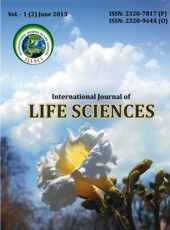Adaptability of Macrophomina phaseolina isolates of pigeonpea (Cajanus cajan L.) to different temperature and pH
Keywords:
Global Warming, Growth Rate, Macrophomina Phaseolina, TemperatureAbstract
Sixty-one isolates of Macrophomina phaseolina were isolated and studied for their adaptability to different temperature and pH. Higher relative growth rate was observed at 30 oC followed by 35 oC. Similarly, Higher mean dry mycelial weight at pH 6 and 7, clearly indicated the preference of isolates to particular range of pH. Different nitrogen sources were found to have a significant effect (p≤0.01) on the physiology of M+ and M- isolates of M. phaseolina.
Downloads
References
1. Anderson PK, Cunningham AA, Patel NG, Morales FJ, Epstein PR and P Daszak (2004) Emerging infectious diseases of plants: pathogen, pollution, climate change and agrotechnology drivers. Trends in Ecology and Evolution, 19:535–544.
2. Babu BK, Srivastava AK, Saxena AK and DK Arora (2007) Identification and detection of Macrophomina phaseolina by using species specific oligonucleotide primers and probe. Mycologia, 99:733–739.
3. Beas-Fernandez R, De Santiago A, Hernandez-Delgado S and N Mayek-Perez (2006) Characterization of Mexican and non-Mexican isolates of Macrophomina phaseolina based on morphological characteristics, pathogenicity on bean seeds and endoglucanase genes. Journal of Plant Pathology, 88:53–60.
4. Crous PW, Slippers B, Wingfield MJ, Rheeder J, Marasas FOW, Philips JLA, Alves A, Burgess T, Barber P and JZ Groenewald (2006) Phylogenetic lineages in the Botryosphaeriaceae. Studies in Mycology, 55:235–53.
5. Csondes I, Sandor K and G Richard (2007) Growth of Macrophomina phaseolina isolates depend on different temperature. Analele Universităţii din Oradea, Fascicula: Protecţia Mediului, vol. XII.
6. Csondes I, Cseh A, Taller J and P Poczai (2012) Genetic diversity and effect of temperature and pH on the growth of Macrophomina phaseolina isolates from sunflower fields in Hungary. Molecular Biology Reports, 39:3259–3269.
7. Garrett KA, Dendy SP, Frank EE, Rouse MN and SE Travers (2006) Climate change effects on plant disease: genomes to ecosystems. Annual Reviews in Phytopathology, 44:489–509.
8. Jha AK and SC Dubey (2000) Occurrence of collar rot of okra in the plateau region of Bihar. Journal of Research Birsa Agriculture University, 12: 67-72.
9. Kaur S, Chauhan VB, Singh JP and Singh RB (2012a) Status of Macrophomina stem canker disease of pigeonpea in eastern Uttar Pradesh. Journal of Food Legumes, 25(1):76-78
10. Kaur S, Dhillon GS, Brar SK and Chauhan VB (2012b) Carbohydrate degrading enzyme production by the plant pathogenic mycelia and pycnidia strains of Macrophomina phaseolina through koji fermentation. Industrial Crops and Products, 36(1): 140-148
11. Kaur S, Dhillon GS, Brar SK, Vallad GE, Chauhan VB and Chand R (2012c) Emerging phytopathogen Macrophomina phaseolina: biology, economic importance and current diagnostic trends. Critical Reviews Microbiology, 38(2):136-151.
12. Maholay MN (1992) Macrophomina seed and pod rot of butter bean (Phaseolus lunatus L.). Indian Journal of Mycology and Plant Pathology, 22:220–226.
13. Manici LM, Caputo F and C Cerato (1995) Temperature responses of isolates of Macrophomina phaseolina from different climate regions of sunflower production in Italy. Plant Disease, 79:834-838.
14. Mayek-Perez N., Lopez-Castaneda C. and J.A. Acosta-Gallegos (1997) Variacion en caracterısticas culturales in vitro de aislamientos de Macrophomina phaseolina y su virulencia en frijol. Agrociencia, 31:187-195.
15. Mayek-Perez N, Lopez-Castaneda C, Gonzalez-Chavira M, Garch-Espinosa R, Acosta-Gallegos J, De la Vega OM and J Simpson (2001) Variability of Mexican isolates of Macrophomina phaseolina based on pathogenesis and AFLP genotype. Physiological and Molecular Plant Pathology, 59:257-264.
16. Mihail JD and SJ Taylor (1995) Interpreting of variability among isolates of Macrophomina phaseolina in patogenicity, pycnidium production, and chlorate utilization. Canadian Journal of Botany, 73:1596-1603.
17. Nischwitz C, Olsen M and S Rasmussen (2004) Effect of irrigation type on inoculum density of Macrophomina phaseolina in melon fields in Arizona. Journal of Phytopathology, 152:133–137.
18. Pun KB, Sabitha D and V Valluvaparidasan (1998) Studies on seed-borne nature of Macrophomina phaseolina in okra. Plant Disease Research, 13:249–290.
19. Sharma VK, Gaur RB and HR Bisnoi (2004) Cultural, morphological and physiological variability in Macrophomina phaseolina. Journal of Mycology Plant Pathology, 34:532- 534.
20. Singh RS and JS Chohan (1982) Physio-pathological studies of Macrophomina phaseolina causing charcoal rot in muskmelon. Indian Journal of Mycology and Plant Pathology, 12:81–82.
21. Su G, Suh SO, Schneider RW and JS Russin (2001) Host specialization in the charcoal rot fungus Macrophomina phaseolina. Phytopathology, 91:120–126.
22. Trinci APJ (1971) Influence of the width of the peripheral growth zone on the radial growth rate of fungal colonies on solid media. Journal of General Microbiology, 67:325-344.
23. Viana FMP, NL-de S and NL De-Souza (2002) Effect of temperature and water tension of the substrate on germination of microsclerotia or M. Phaseolina. Summa phytopatholgoica. 23:236-239.
24. Yang XB and S Navi (2003) Charcoal Rot-A dry weather disease. Integrated Crop Management, 22:166-16.
Published
How to Cite
Issue
Section
License
Copyright (c) 2013 Authors

This work is licensed under a Creative Commons Attribution-NonCommercial-NoDerivatives 4.0 International License.
Open Access This article is licensed under a Creative Commons Attribution 4.0 International License, which permits use, sharing, adaptation, distribution and reproduction in any medium or format, as long as you give appropriate credit to the original author(s) and the source, provide a link to the Creative Commons license, and indicate if changes were made. The images or other third party material in this article are included in the article’s Creative Commons license unless indicated otherwise in a credit line to the material. If the material is not included in the article’s Creative Commons license and your intended use is not permitted by statutory regulation or exceeds the permitted use, you will need to obtain permission directly from the copyright holder. To view a copy of this license, visit http://creativecommons.org/ licenses/by/4.0/











